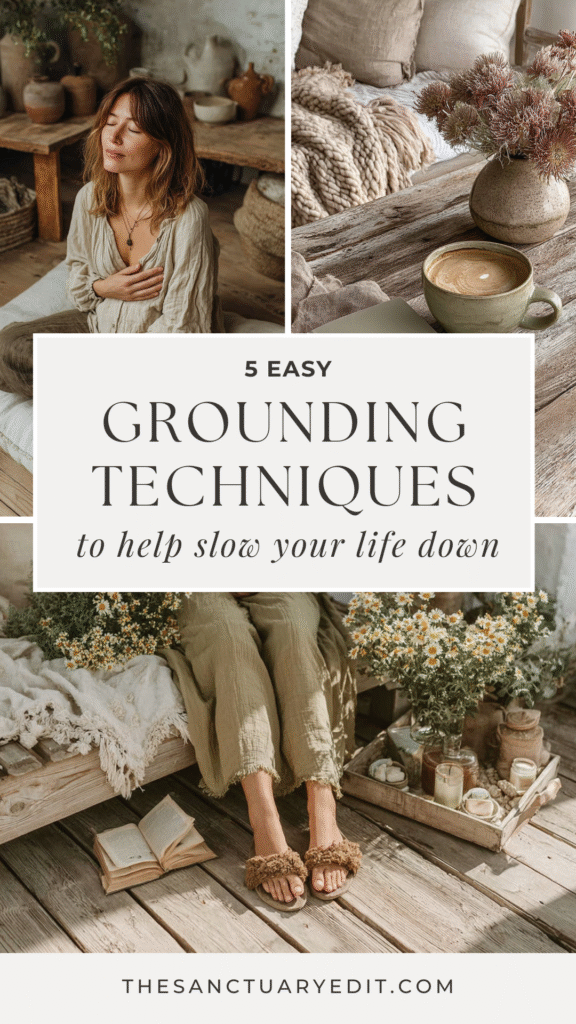This post may contain affiliate links, including those from Amazon Associates. If you make a purchase through these links, I may earn a commission at no additional cost to you. Learn more about our affiliate policy.
There are days when the pace of life pulls you in every direction, emails, errands, and endless notifications tugging at your attention.
Your body moves faster than your breath, and by evening you feel untethered. In moments like these, grounding becomes a gentle anchor.
It draws you back to the present, reconnects you with your body, and reminds you that life doesn’t have to move at such a speed.
Grounding techniques don’t require special tools or long retreats. They’re small, simple practices you can weave into your day wherever you are. By engaging your senses, slowing your breath, or connecting with the natural world, you can shift from scattered to steady.
Here are five grounding techniques that help slow your life down.
Why Grounding Matters
Grounding is about presence. It interrupts the cycle of racing thoughts and invites your nervous system into balance.
Rather than escaping your life, grounding allows you to inhabit it more fully, breath by breath, step by step.
When practiced regularly, these techniques help regulate the body, reduce overstimulation, and create space for clarity. In a culture that thrives on speed, grounding reminds you that slow is not only possible, it’s nourishing.

1. 5-4-3-2-1 Senses Check
One of the simplest ways to return to the present is to engage all five senses. This exercise is called the 5-4-3-2-1 technique, and it gently guides your awareness back into your body.
Here’s how it works:
- Notice five things you can see. Look around the room for color, shape, light, or shadow.
- Notice four things you can touch. Feel the fabric of your sleeve, the smoothness of a tabletop, the ground beneath your feet.
- Notice three things you can hear. Let your ears tune into background sounds: birds outside, the hum of the fridge, the quiet rustle of leaves.
- Notice two things you can smell. Inhale deeply—perhaps the faint scent of wood, your cup of tea, or fresh air drifting in through an open window.
- Notice one thing you can taste. Take a sip of water, chew a piece of mint, or simply notice the lingering taste in your mouth.
This sensory scan shifts your focus from the noise in your mind to the reality of your environment. It’s especially helpful when you feel anxious or overstimulated. The act of naming what you perceive steadies you in the moment.
2. Breath and Body Awareness

Breath is the most accessible anchor. It’s always with you, quietly bridging body and mind. When life feels chaotic, slowing your breath signals to your nervous system that it’s safe to rest.
Begin by placing one hand on your belly and the other on your chest. Inhale gently through your nose, feeling your belly rise under your hand. Count to four or five as you breathe in.
Pause briefly, then exhale slowly for five or six counts, letting your body release tension.
Pairing this with a light body scan deepens the practice. As you breathe, bring your attention down to your feet.
Notice the sensation of them resting on the floor. Move upward to your legs, hips, torso and shoulders, pausing at each area to observe tightness or ease. The goal isn’t to fix anything, only to notice and allow space for release.
This kind of breath and body awareness is simple enough to use in daily transitions like before a meeting, at the end of work, or right before sleep. Each cycle of breath draws you back into your body’s natural rhythm.
For more ideas on creating a supportive environment for your body and mind, explore this guide on how to create a peaceful home that supports nervous system regulation.
3. Touch and Texture Anchor

Sometimes the quickest path to slowing down is through your hands. Holding an object with intention draws your senses into the present moment.
Choose something natural if you can. A smooth stone, a branch of eucalyptus, or the textured surface of a terracotta pot. Run your fingers slowly over its edges. Notice temperature, weight, and detail. The more closely you pay attention, the more your mind begins to settle.
Plants are especially grounding companions. Place your hand on a large leaf and trace its veins. Hold a small pot of herbs, feeling the soil beneath your fingertips and inhaling its fragrance.
Even brushing your palm against dried grasses or woven fibers invites your senses to quiet.
If you spend much of your day indoors, keep a small grounding object close like a piece of driftwood on your desk, a pocket stone from a favorite walk, or a sprig of rosemary in a jar. In moments of restlessness, holding it is a reminder of the earth’s steadiness.
You can deepen this connection by adding calming greenery to touch, here are some easy indoor plants that elevate your earthy decor.
4. Movement with Feet on the Ground
Grounding doesn’t always require stillness. Sometimes the body needs to release energy through movement.
Bringing awareness to your feet is a powerful way to reconnect with the present.
Stand up and notice the weight of your body pressing into the floor. Feel each point of contact—heels, arches, toes. Slowly shift your weight side to side, forward and back, noticing how the floor supports you.
You might take a slow walk around your room or outside, paying attention to each step.
The rhythm of your feet meeting the earth becomes a mantra. Walking barefoot on grass or soil adds another layer of sensory grounding, the coolness of dew, the firmness of earth, the softness of moss.
Even a simple practice like pressing your toes into the floor while seated can redirect your energy. Movement reconnects you to your body, reminding you that you are held, supported, and present in this moment.
5. Mental Anchor and Gentle Reframing

Grounding can also happen through the mind, especially when thoughts feel scattered. By giving your mind a soft anchor, you create order within the swirl.
One way is through an anchor statement: say your name, where you are, and a simple truth about your surroundings. “I am here, sitting in my bedroom, the afternoon light is warm on the floor.” Speaking facts aloud settles the nervous system by affirming the safety of the present moment.
You can also ground by naming categories. List as many trees as you can think of, or recall your favorite herbs and flowers. This simple act pulls your thoughts into a gentle rhythm.
Another option is to recall a place you love in detail. Imagine standing in that landscape. What colors do you see? What scents drift through the air? This mental imagery brings your body into alignment with calm memories, slowing the urgency of the present.
The key is gentleness. Choose words or images that soothe, not ones that demand effort. Mental anchors are not about controlling thoughts, but about redirecting them toward steadiness.
When to Use Grounding
Grounding is most effective when woven into everyday life. Pause in the morning before reaching for your phone.
Use a technique before making a big decision, or in the quiet moments before sleep. In times of overwhelm, grounding provides a reset that doesn’t require leaving your environment, it transforms your relationship to it.
Small rituals add up. A breath before you open your inbox. A leaf traced with your hand before dinner. A short walk with attention on each step.
These become moments of restoration threaded into an ordinary day.
Cultivating Grounding as a Practice
Like any habit, grounding deepens with repetition. Practice even when you don’t feel overwhelmed, so your body learns the path to calm. Try mixing techniques, perhaps a senses check in the morning, breath awareness mid-day, and a grounding object before bed.
Create a small ritual space in your home: a corner with a plant, a candle, and a comfortable cushion. Return there often, even for five minutes. Over time, your body will begin to associate that spot with calm.
Notice the subtle shifts. Does your breath lengthen? Do your shoulders drop? Does your mind feel clearer? Grounding is less about dramatic change and more about steadying the current of your day.
If you’re building daily rhythms around grounding, you might also enjoy these slow living morning routines for a peaceful day.
Invitation
Slowing down doesn’t require an escape from life, it asks for presence within it. Grounding techniques are small, human ways of remembering that you are here, now, supported by the earth beneath you.
Try one technique today. Place your hand on a plant leaf and notice its cool veins. Walk barefoot outside for a few minutes. Pause for a slow breath before you move on. Each act is a reminder: life feels different when lived at the pace of the body rather than the pace of the world.


